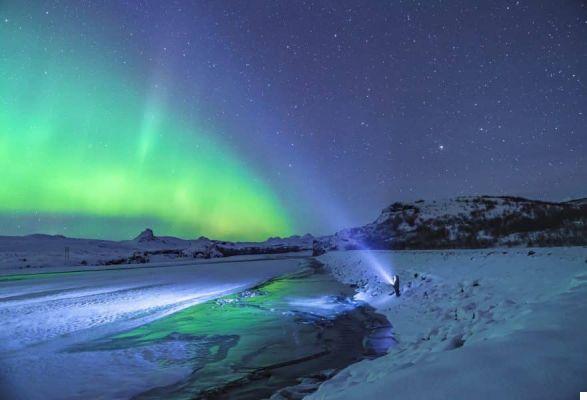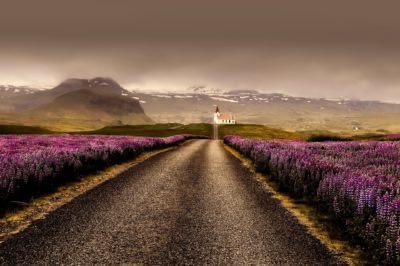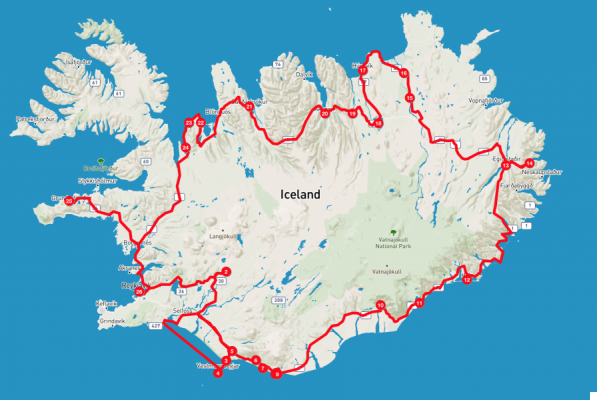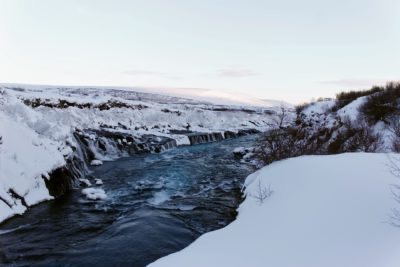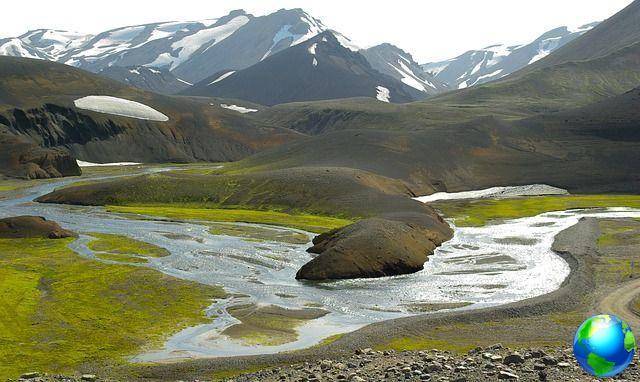A journey to this land of extreme contrasts at the edge of the Arctic Circle is a journey into the purest and most uncontaminated nature. Even knowing that it was a country really full of incredible things to see, I didn't think it was so, I didn't think that every day I would see so many places completely different from each other, waterfalls, glaciers, lakes, canyons, beaches, geysers, volcanoes ... all possible forms in which nature can express itself. The thing that struck me the most is definitely the water. There is water everywhere in Iceland, an infinity of waterfalls, rivers, glaciers..where you look there is water. Another thing I was not prepared for is the unpredictability of the weather, the weather changes every 5 'and you go from sun to flood, from hail then back to clear in a few hours. Let's say that the weather forecast leaves the time they find!
But let's get to the point… choosing what to see in Iceland is a difficult task and, even if you do like me (who I ran every day to see as much as possible), you will only be able to see a small part of what it offers. Already put your soul in peace. The itinerary I followed is the classic itinerary along Ring Road N.1, the circular road that runs throughout the island. It's a 10 days itinerary, which is the minimum number to be able to do the full circle. This itinerary can be done approximately from April to November; in the winter months it is highly discouraged because in the northern part of the island the roads could be closed due to snow / ice. If you intend to go there in winter I recommend you to follow a shorter itinerary, of 7 days, which focuses on the south-west and south of Iceland (you can find this itinerary at the end of the article).
As for the organization of the trip, you will find all the info in these 2 articles:
- Travel to Iceland: all the tips on how to organize it
- Low cost Iceland: 10 ways to save
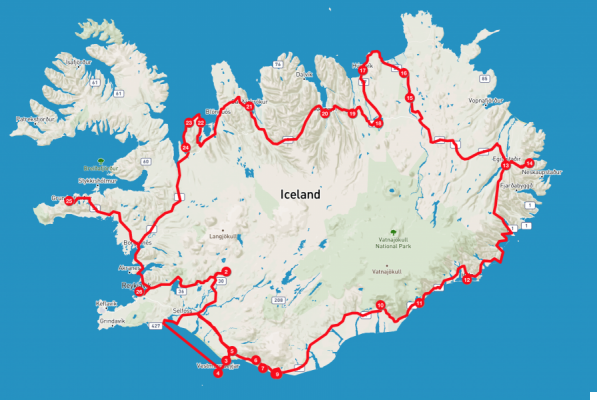
What to see in Iceland in 10 days: itinerary along the Ring Road N.1
Day 1: Reykjavik and Fagradalsfjall Volcano
Reykjavik
Reykjavik is the northernmost capital in the world, just north of the 64th parallel. Until the end of the 800th century it was little more than a fishing village so it is a modern city, small, but with a certain character. It is a lively and full of life city and I was very impressed to always see a lot of young people on the street, even late at night, regardless of the weather and temperatures. Icelanders love to have fun and are very nice to everyone. Thinking of how far north it is… I am loooong more than Norwegians, Finns and Swedes! Among the things to see in Reykjavik (all within walking distance) are:
- Harp. This modern beachfront property houses a concert hall and Reykjavik Convention Center. If you can, go up to the 5th floor with the elevators to appreciate the architectural structure more.
- Solfar. on the waterfront, not far from the Harpa, is the Solfar, a large metal sculpture representing a stylized Viking ship: it's nice and perfect for taking a picture with the bay and Mount Esja in the background.
- Hallgrimskirkja Cathedral. Its shape is inspired by the basalt columns typical of Iceland and has become the symbol of the city. For 1000 ISK you can climb to the top of the bell tower and have a nice view over the whole city.
- Walk in the "old town". Stroll around Laugavegur which is full of cute little shops, clubs, bars and restaurants. In the evening the young people gather here.
- Raohus (Town Hall) and Tjornin pond. Inside the town hall there is a huge model representing all of Iceland (and you will realize how much surface is covered by the ice); immediately in front there is a beautiful pond with swans.
Active volcano of Fagradalsfjall
** updated October 2021 **
On March 19, 2021, after 900 years of inactivity, the Fagradalsfjall volcano he woke up! After several earthquakes and swellings of the ground, a 500-700 meter crack opened in the earth's crust and began to erupt with some regularity. You can check the activity of the volcano and understand if it is erupting or not through this site. This volcano is located only 40 km from Reykjavik and can be visited up close in a completely safe way. You will have to park your car in this paid parking lot built for the occasion (1.000 ISK, approximately € 6,5) and from there proceed on foot along one of the 3 marked paths, A, B, C. The most spectacular are the paths B and C that climb the hills side of the crater. The treks are about 8 km long, round trip, in the first part you go up, then you go down next to the flow to get to the lava pool, finally you return to the parking lot. If you want to walk less, opt for path A. There is no danger, but you must always follow the instructions of the Civil Protection and the Icelandic Red Cross who constantly check that there are no excessive harmful gases in the air. It is clearly not known how long this eruption can last, whether months or years, so it is better to take advantage of it !! When does such an opportunity come back to you? NB I am told by the director that the kiosk located in the parking lot makes excellent hot dogs and hot soups at very affordable prices.
Where to sleep in Reykjavik
Luna Apartments - beautiful apartments of various sizes right in the city center.




Day 2: Golden Circle and transfer to Vestmannaeyjar Island
We leave Reykjavik to reach what is called the "Golden circuit”, A linguistic invention for tourists, because this area is the most visited in the country. I have dedicated the morning and early afternoon to visit Geyser and Gullfoss and then go to the port of Landeyjahofn to take the ferry to lVestmannaeyjar Island (1h of navigation - here you will find the ferry timetables). Among the things not to be missed in the Golden Circle are:
Geysir
Iceland is the largest volcanic island in the world and is characterized by intense geothermal (as well as volcanic) activity which makes it almost autonomous from an energy point of view. One of the most spectacular manifestations of this activity are their own the geysers, named after this Icelandic location, which represents the largest geothermal area in the world. Here you can see several active geysers that "explode" every 5-10 'minutes and whose jets of water can reach up to 30 meters (before the 50s it seems they reached 30-60 meters!). I had never seen them before and I must say that they are particularly impressive !! Of course, everything is accompanied by a nice smell of sulfur ..
The Gullfoss waterfall
A few kilometers from Geysir is located Gulfoss (Golden Falls), nicknamed the "queen of all Icelandic waterfalls" for its size and theatricality. The falls are 32 meters high and have an exceptional water flow. The peculiarity is that the waters flow into a canyon (the gorges of Gulfoss) where they practically end up exploding. There are several viewpoints that can be reached with a path.
Where sleeping in Vestmannaeyjar
Hotel Vestmannaeyjar : the most beautiful hotel on the island, with excellent spa and bar / restaurant interiors


Day 3: Vestmannaeyjar Island, Seljandsfoss, Skogafoss and DC-3 Plane Wreck
This day is very intense, you will walk a lot, but you will see some truly incredible places! If you think this is too much to do in a single day… consider skipping the DC-3 Plane Wreck if necessary.
Vestmannaeyjar Island
I speak of an island but we should speak of an island, of the Vestmannaeyjar archipelago, located about 10 km from the coast. It consists of 15 islands and many islets; the 2 largest islands are Heimaey (the only one inhabited) and Surtsey (UNESCO World Heritage Site, open only to researchers). Heimaey is a real gem, and you notice it immediately when you enter the port, which is located at the bottom of a kind of fjord with cliffs overlooking the sea. Among the things to see there is the Salita al Vulcano Eldfell (about 1h- it erupted in 1973 increasing the surface of the island by 20%!) from which you can enjoy a crazy view over the whole island, Storhofoi and the cliffs of the west coast, the Puffin colonies on the Heimaklettur near the port (only from May to about mid-August) and the golf course inside the crater on the northwest coast of the island. The landscapes here are truly crazy! You can see everything in the morning, then return to the mainland before lunch.
The Seljandsfoss waterfall
From the port of Landeyjahofn in 15 'you reach the Seljandsfoss waterfall, where the water falls with a jump of 40 meters from a rocky spur. This is the only (at least I think ..) waterfall where you can go behind the water (not without getting wet, I warn you!). It is truly scenic! If you follow the path that runs along the mountain you can also reach the small one Gljufrabui waterfall, passing by a rift in the mountain and walking into the water. I tell you it's worth it!
The Skogafoss waterfall
With another 30 'of road you arrive at the Skogafoss waterfall, another magnificent waterfall, often framed by the rainbow. It can be seen from below, but it is also worth climbing the steps on the right to be able to see it from above. At the top of the staircase, among other things, he leaves one of the most famous treks in Iceland, which leads to the top of the volcano that erupted in 2011 blocking flights from half of Europe (the Eyjafjöll volcano). To get to the top it takes about 5-6 hours (walking at a good pace), plus 3-4 hours to descend. Near Skogafoss (you have to make a detour before reaching the waterfall) there is Seljavallalaug natural swimming pool (free), a 25-meter pool completely immersed in nature.
DC-3 Plane Wreck: the wreck
We are talking about one of the most photographed spots in Iceland, the famous hulk of the US Navy Douglas Super DC-3 which was forced to an emergency landing on the remote beach of Sólheimasandur on November 24, 1973. They were all saved but the plane came abandoned there. To reach it you have to walk about 3,5 km (one way) following a completely flat dirt road. In the summer it is invaded by tourists at all hours of the day and night so..boh ... honestly I would not recommend it. In the low season it is beautiful and photogenic especially at sunrise, sunset and at night (with the hope of seeing the aurora). Between going and coming back, however, calculate at least 2h-2h 30 'you take lots of photos and it is nice to reach the beach too).
Where to sleep in Vik
Black Beach Suites very nice apartments overlooking the coast and the sea




Giorno 4: Dyrholaey, Reynisfjara (Black Beach), Svartifoss, Jokulsarlon
This day is also very busy, but it is absolutely worth it!
The cliffs of Dyrholaey
The first stop of the day is there Dyrholaey Peninsula with imposing cliffs where many seabirds find shelter (between June and August it is possible to see puffins, sea gulls). There are two observation points, one at the Lighthouse and one further down: go to both because the view of the coast and Black Beach is truly magnificent.
Reynisfjara (Black Beach): the black beach
You will have seen it from above but up close it is even more beautiful! Reynisfjara is the most famous black beach in Iceland and there are some beautiful basalt formations. The waves of the sea here are very violent so be really careful! There are many signs but, despite this, there were also several deaths .. people who went to take pictures near the shore that was literally sucked into the sea.
Skaftafell: the waterfall and the glacier
Proceeding east, after about 160 km you will arrive in Skaftafell Natural Park, at the foot of the largest Icelandic glacier (The Vatnajokull, occupies an immense surface, 8400 square meters with a thickness of up to 1 kilometer!). Remember to pay for parking at the machines because there are cameras out and you get a fine otherwise! Here you can do different routes, of different length and difficulty. The "must" is the circular path that reaches the view point di Svartifoss and continues until you reach the base of the Svartifoss waterfall, famous for its beautiful organ pipe basalt rocks. It will take you about 2 hours to do the whole tour. Leaving the Skaftafell car park, after about 2 km on the left there is a dirt track (another 2 km long) that practically arrives at the foot of the glacier. Go there because it is spectacular and you will be just a few meters from the ice tongue and icebergs. The name of this glacier is Svinafellsjokull.
Jokulsarlon e Diamond Beach
Let's end the day with a flourish with one of the places I loved the most, the Jokulsarlon, a lagoon 200 meters deep which was formed by the action of one of the Vatnajokull glacier tongues. The lagoon was formed around the '30s when the glacier began to regress (how sad ..) also fed by sea water. The best time to visit is late afternoon / sunset. The landscape is polar, with immense icebergs moving in the lagoon inhabited by seals. To better appreciate it, I suggest you take part in one cruise with an amphibious vehicle which lasts 1h (in high season it is better to book it in advance - it costs 40 euros per person but it is worth it all). After the cruise, go and see Diamond beach, where there are the icebergs that come out of the lagoon that break with the waves and end up on the black beach… simply gorgeous !!
Where to sleep in Hofn
Fosshótel Vatnajökull - very nice hotel just outside Hofn, with beautiful mountain views





Day 5: Egilsstadir and Seydisfjordur
The approximately 200 km that separate Hofn from Egilsstadir are very scenic and you can also make many stops to take pictures. Once you get to Egilsstadir you can reach it Seydisfjordur, the "city of artists" because of its colorful houses. Seydisfjordur is a small fishing port and is located at the bottom of a deep fjord: this is where ferries to the Faroe Islands arrive and depart and this is where it is. Iceland's most instagrammed colorful street. Returning to Egilsstadir you can stop to see the little one too Gufufoss waterfall (you can find it on the left). After the last 2 very busy days, my advice is to dedicate the afternoon (or at least a few hours) to relaxation in the brand new floating pools of the Vok Baths inaugurated right in 2019.
Where sleeping in Egilsstadir
Guesthouse - Lake Hotel Egilsstadir - a beautiful renovated farmhouse next to the lake, excellent restaurant


Day 6: Dettifoss and Asbyrgi
If you don't want to lose the rhythm of the first days, you can add it to the visit of Dettifoss and Asbyrgi Stuðlagil Canyon, making a small detour about 1 hour from Egilsstadir. This canyon is famous because in several places there are perfectly hexagonal granite blocks. There should be view points on both sides of the canyon, but to see these rocks well, you have to go trekking. I went to the right side of the canyon and, from the view point, you can see a little, but not too much, so in case you decide to go .. take the road that runs on the left side of the canyon.
The Dettifoss waterfall
To reach Dettifoss you have to deviate from the Ring Road and take road N.864 (dirt road .. it can be particularly bad in some places). If you don't stop at Stuðlagil Canyon, from Egilsstadir it takes about 2 hours and a half to get there. Dettifoss is the most powerful waterfall in Europe with an average water flow rate it is 200 cubic meters per second. Around the waterfall and the canyon on which the landscape is thrown is lunar, a stone desert that smacks of post-apocalyptic scenery. From the car park you can then reach various view points on foot. Continuing towards Asbyrgi, after a while there is a small detour that is worth taking to reach the view point of Hafragilfoss from which you can enjoy a magnificent view of the canyon.
The Asbyrgi canyon
The Dettifoss canyon itself then continues towards the sea and the canyon, ad Asbyrgi, takes the form of a horseshoe inside which everything is, on the contrary, very green. This part of the canyon is called the "refuge of the gods" and from here there are about twenty paths. If you do not have much time, arrive by car to the internal parking and take the shorter path (called A1) to reach the lake.
The Geosea geothermal pool
End the day in the brand new geothermal pool GeoSea in Husavik. This infinity pool is located in front of the sea and has a beautiful view of the Husavik fjord. The cost is around 30 euros (2020).
Where sleeping in Husavik
Guesthouse Brekka - basic but nice apartments a few km outside Husavik



Day 7: Husavik, Myvatn and Godafoss
Even this day will be very intense and you will have to pay attention to the clock so as not to miss anything (in reality the things to see would be double but you have to be satisfied ..).
Whale Watching a Husavik
If you have never seen a whale I would miss this opportunity. Husavik is considered the whale watching capital of Europe and seeing a whale or humpback whale is quite common here. From April-May until October-November there are several companies that organize this activity several times a day on retrofitted fishing boats or fast boats. The activity lasts 4h and costs around 75 euros per person. I went with the North Sailing and I was fine (as for the amphibious vehicle of Jokulsarlon, if you go in high season book in advance!). They provide all the equipment (or rather harness) against water and cold and, at the end of navigation, they offer coffee or hot chocolate and pastries. Obviously it is not mathematical to see whales, but it is very rare to return to land without having seen a single one. I have been very lucky and have seen several, even from very close. I forgot, it can happen that the sea is very rough so: 1) have a very light breakfast; 2) take a pill if you suffer from the sea like me.
Myvatn: craters, solfataras, caves and natural pools
In 45 'driving, from Husavik it can be reached Myvatn, an area that literally drove me crazy !! All the things to see are located around the great lake of Myvatn. The ones that I absolutely recommend not to miss are: 1) Hverir, a geothermal site full of sulphates and puddles of boiling mud .. a landscape that is nothing short of Dante! 2) the Hverfell crater, whose mouth can be reached on foot with a 20-30 'climb, very beautiful and with a beautiful view; 3) the Gjotagja cave with hot thermal water where they filmed a famous Game of Thrones scene. If you have more time, you can consider taking a couple of hours to relax Myvatn Nature Bath in Myvatn, very similar to the Blue Lagoon.
The Godafoss waterfall
The day ends with a flourish the most beautiful waterfall in Iceland (at least for me): Godafoss .. the waterfall of the gods. It is not very high, but it is located in a kind of natural amphitheater and is made up of an infinity of small waterfalls. Maybe I went there at the end of the day and it wasn't very crowded, but seeing it was pure poetry!
Where to sleep in Akureyri
Hotel Kjarnalundur - large and comfortable hotel a little outside the city, immersed in the woods.





Day 8: Glaumbaer and Vatnsnes peninsula
This day is a tad more relaxed, but you can of course add places and experiences, such as one Horse ride between Glaumbaer and the Vatnsnes peninsula. In case you are interested, I advise you to contact Iceland Horse Tour . The walk lasts 1h and costs about 35 euros (whoever did it was very happy!).
Glaumbaer (peat houses)
In Glaumbaer there is a peat building complex built between the 800th and XNUMXth centuries and is one of the most famous farms in Iceland. If you are interested in knowing how they lived at the time, you can visit the small museum there, otherwise enjoy an excellent homemade cake in the café next door (which is in a very beautiful building from the end of the XNUMXth century).
Vatnsnes Peninsula
The Vatnsnes Peninsula is where there is the greatest concentration of seals in all of Iceland (and I would say wild horses too!). Seals are easily sighted because they swim close to the beach and rocks. The road that allows you to go around the whole peninsula is the state road N.711 and it is ALL dirt! Before deciding to do it, check the state of the road from this site. When I walked it some of the pieces were really hard core even for the 4 × 4, not to mention the fact that we were blocked by a herd of horses that took a tooth and hoofed the hood hahaha .. what a good time! The first stop is the east side: Hvitserkur, the huge (and scenic) rhino-shaped rock that can be reached with a short walk on the black beach at low tide (pay attention to the path to go down to the beach: it is rather steep, but very short). From here you can walk along the coast to spot seals. Continuing there are then other points of sighting of seals. On the west side there are: Illugastadir and Svalbard. The peninsula is truly wild and the landscapes will repay you for the hours it takes to travel it.
Where sleeping in Hvammstangi
Huts in Víðidalur - small wooden cottages (with external bathroom) immersed in the woods



Day 9: Snæfellsnes peninsula and return to Reykjavik
On the way back to Reykjavik, several stops along the way are absolutely worthwhile Snæfellsnes peninsula. From Hvammstangi it takes almost 3h to reach the first place, that is cascata Kirkjufellsfoss and monte Kirkjufell (one of the best photographic spots in Iceland, often shot in Game of Thrones) and a whole series of lava zones, lighthouses and cliffs. From there, continue along a beautiful and super-panoramic road until you reach the famous Black Church (Buoakirkja Black Church). Here you can take a walk around the church, until you reach the sea. At this point the trip is about to end and you just have to sadly return to Reykjavik to visit it (if you didn't see it on the way). If you want to finish with a flourish and don't want to spare any expenses, you can possibly consider going to the Blue Lagoon, which is located not very far from Reykjavik.



Day 10: return home
7-day winter itinerary for the Northern Lights
As I also wrote above, the complete tour of Iceland is not feasible in the middle of winter (at least if you do not have special means and equipment). Winter itineraries usually focus on the southern area, more or less with a program similar to this:
- Arrival in Reykjavik
- Golden Circle (Geyser, Gulfoss, etc.) and hot spring
- Vik, Dyrholaey, Reynisfjara (Black Beach)
- Jokulsarlon and the ice caves
- Seljandsfoss, Skogafoss e DC-3 Plane Wreck
- Snæfellsnes peninsula
- Return to Reykjavik
